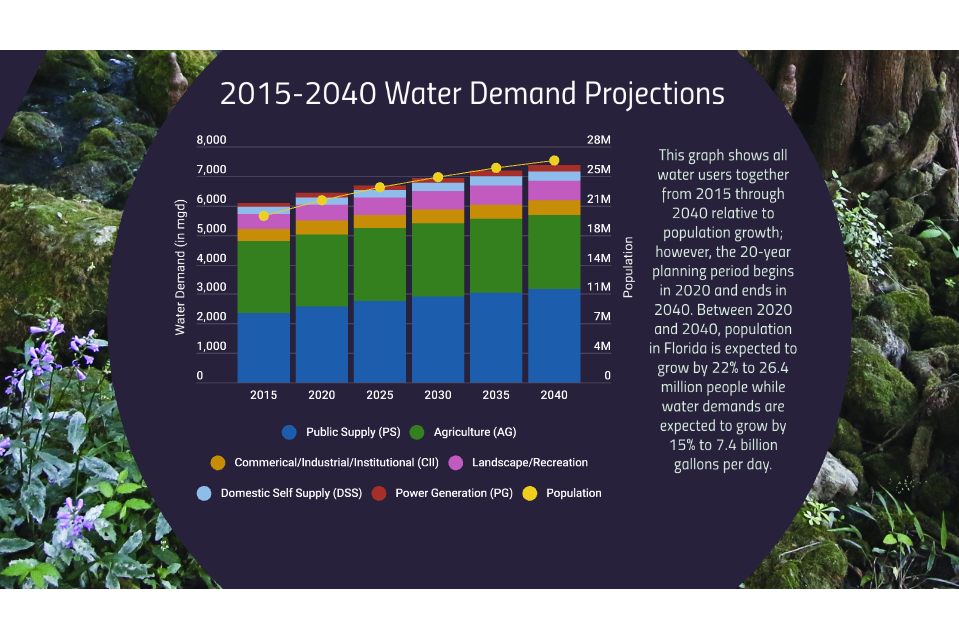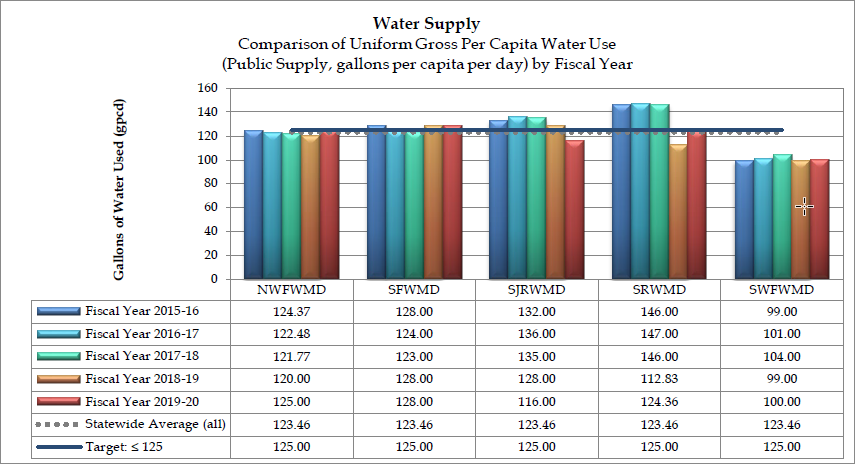“The protection of water resources is one of the most pressing issues facing our state. That’s why today I’m taking immediate action to combat the threats which have devastated our local economies and threatened the health of our communities.” – Ron DeSantis, 46th Governor of Florida, on new legislation concerning Florida’s Regional Water Supply Plans (RWSPs) 4
What are Florida's Regional Water Supply Plans (RWSPs)?
Florida’s water resources hang in the balance of natural supply and evolving human needs. As a result of depleted, polluted, and otherwise mistreated water resources throughout the state, Regional Water Supply Plans (RWSPs) became a mandatory practice. These plans take multiple factors into account based on regulations in The 2022 Florida Statutes.1 They include a quantification of water supply needs within the planning horizon, a list of water supply development project options, and various progress assessments.
RWSPs are based on a twenty-year planning period that assesses projected reasonable-beneficial needs and determines potential sources of water to meet them. They are the modern framework for dealing with alternative water sources, current sources of fresh groundwater, and conservation methods until 2040. The four core mission areas of each policy are Water Supply, Water Quality, Flood Protection & Floodplain Management, and Natural Systems Protection; these are reevaluated every five years.

Photo credit: South Florida Water Management District
As shown on the left, Florida currently has five water management districts (WMDs) that were created in 1976:
- Northwest Florida Water Management District
- Suwanne River Water Management District
- St. Johns River Water Management District
- Southwest Florida Water Management District
- South Florida Water Management District
Each WMD develops its plans using an open public process. This prioritizes cooperation from authorities, suppliers, and all other interested parties – including civilians. Consider these the blueprints for each region’s economy, quality of life, and environment. This is all accomplished by preserving water – one of our most valuable and endangered natural resources.
Why Does Florida Need Regional Water Supply Plans?
It may be surprising that a state that averages more rain in a year than most states would worry about its water supply. However, the South Florida Water Management District (SFWMD) alone utilizes 3 billion gallons of water on a daily basis to support its 9 million residents and tourists.2 Furthermore, current practices are creating a strain on our coastal and freshwater resources. They are not sustainable given the projected water demands, as calculated below.

Photo credit: Florida Department of Environmental Protection
It is essential that every agency, authority, and individual does their part to supersede the minimum requirements for water quality and quantity. The water sources that everything depends on often do not receive the necessary support from our state officials. As a result, water infrastructure is aging rapidly and is in grave need of repairing or upgrading. The distribution of water is a massive and ongoing undertaking that requires years of planning, resources, and financial aid to stay ahead of population growth. The more state officials adhere to Florida’s Regional Supply Plans, the safer our natural ecosystems, economy, and access to water are.
A major piece to making successful RWSPs are finding ways to create or utilize alternative water supplies. For example: reclaimed or recycled water, capturing rainfall, and desalinating salt water through reverse osmosis treatment. Reclaimed water can be used for irrigation, maintaining wetlands, recharging groundwater, and several industrial needs (cooling, processing, and washing). 3
Are Florida's Regional Supply Plans Actually Sustainable?
The short answer is: absolutely! However, Florida’s Regional Supply Plans focus on maintaining the status quo of our waterways. This means meeting the needs of a growing population, a tourist-dependent economy, and adapting to projected issues spawned by climate change with minimal changes. From an environmentalist perspective, these efforts may prove to be too little too late.

Photo credit: Florida Department of Environmental Protection
On a more positive note, this tactic has empowered districts to make huge strides in water conservation. Over 1,000 projects are already complete, and nearly 300 more are in progress throughout the state. The Department of Environmental Protection confirmed that these alone will make 1,686 millions of gallons per day available for use.
For instance, consider the Everglades. The South Florida Water Management District (SFMD) has worked closely with multiple agencies to carry out the Comprehensive Everglades Restoration Plan, or more specifically to this article, the Everglades Agricultural Area Reservoir Project (EAA). Construction of this 10,700-acre reservoir will begin in 2023 to divert water from Lake Okeechobee to the Everglades instead of the Caloosahatchee river without causing any damage to the latter. Additionally, the adjacent stormwater treatment area will continue to treat negative discharge, nutrient loads, and unhealthy salinity regimes before the freshwater reaches the St. Lucie Estuary.
How Can Someone Get Involved?
Here are ways to get involved with local Regional Water Supply Plans (RWSPs):
- Adopt habits that conserve water. Check out a previous blog on 10 Easy Ways to Conserve Water Daily! 5
- Educate yourself and stay up-to-date about RWSP initiatives; for instance, residents of Central Florida can subscribe to the CFWI newsletter for media that highlights the successes and ongoing projects taking place within the area.
- Volunteer through local nonprofits – like IDEAS For Us – or the official Protecting Florida Together Volunteer Connect Page.6
- Contact your regional representatives.
- Participate in the open public process.
- Vote in local elections.
Each of the five management districts has a governing board whose members are primarily unpaid volunteers. These individuals are appointed by the governor and confirmed by the Florida Senate for four-year terms. By electing local leadership that represents your sustainable values, it is more likely that regional representatives and the appointed executive director will also emulate these ideas.
Sources:
- http://www.leg.state.fl.us/Statutes/index.cfm?App_mode=Display_Statute&Search_String=&URL=0300-0399/0373/Sections/0373.709.html
- https://www.sfwmd.gov/our-work/water-supply
- https://floridadep.gov/water/domestic-wastewater/content/uses-reclaimed-water#:~:text=Reclaimed%20water%20can%20be%20used%20for%20many%20purposes%20including%3A&text=Agricultural%20uses%20such%20as%20irrigation,Wetlands%20creation%2C%20restoration%20and%20enhancement
- https://www.flgov.com/2019/01/10/governor-ron-desantis-announces-major-water-policy-reforms/
- https://ideasforus.org/10-easy-ways-to-conserve-water-daily/
- https://protectingfloridatogether.gov/volunteer








